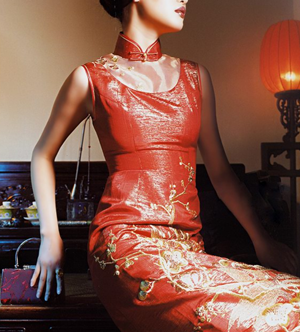|

|
In 1929, with the influence of European and American short -sleeved shirts, the cheongsam,which used to be modesty in length, began to shorten. The lap was shortened to the knee, and its cuff became shorter and smaller. Then there was a school uniform-style cheongsam, the lap of which was shortened to just one inch above the knee, and its sleeves were Western style. The change was criticized by the public, so after 1931 the cheongsam began to become long, with a drooping lap. In the middle 1930s, the length of the cheongsam came to its top. The lap drooped to the floor, covering the feet. That was called a "sweeping cheongsam." The sleeves, which used to cover the wrist, were shortened to the elbow. After that, the sleeves became shorter and shorter until they were 2 inches below the shoulder. Cheongsams became nearly sleeveless after 1936. The cheongsam was not deeply forked in the past. When its sleeves were shortened, it was also split in two on the left side. Then the slit became higher and higher, going as high as the thigh. Due to public opposition, the slit gradually grew back to the knee or below. With the decrease of public pressure, the slit was shortened again rapidly. After 1933, the cheongsam with a high slit was very popular.
In recent years, people added many modern design elements to the cheongsam. Different designers had their own styles, which were exhibited in the changes to the lap of the garment, some of which were asymmetrical or patched. Some even changed the straight collar to a deep V or exaggerated the straight collar.
Calendars
Commercial calendars appeared in Shanghai in roughly 1910 or so, and reached their peak in the 1930s. At the same time, the cheongsam was popular and was frequently featured in the calendars. Models wearing the costume often were used to advertise filter-tip cigarettes, soaps, toilet water, baby's milk powder, and nearly anything else.
